


Understanding Fall Arrest Systems Ensuring Safety in Height Work
Working at heights is an integral part of various industries, from construction to maintenance. However, it comes with significant risks, particularly the potential for falls. Fall arrest systems are essential safety measures designed to prevent such accidents and ensure the well-being of workers. This article delves into the key aspects of fall arrest systems, their components, and their importance in promoting safety.
What is Fall Arrest?
Fall arrest refers to the use of equipment and systems designed to stop a person from falling from a height or to minimize the distance and impact of a fall. Unlike fall restraint systems, which prevent a fall from occurring, fall arrest systems allow a worker to work freely but use safety equipment to mitigate the consequences of a fall.
The primary goal of fall arrest systems is to protect workers from injury or death if they do fall. This is particularly crucial in work environments such as construction sites, roofs, and industrial areas, where heights can pose a serious risk.
Components of Fall Arrest Systems
A fall arrest system typically consists of several key components
1. Anchor Points These are secure attachment points for fall arrest equipment, such as harnesses and lanyards. They must be capable of supporting the total weight of the worker and any potential forces generated during a fall.
2. Full-Body Harness A full-body harness is worn by the worker and distributes the forces of a fall over the body, reducing the risk of injury. Proper fit and adjustment are essential for effectiveness.
3. Lanyard or Lifeline This component connects the harness to an anchor point. Lanyards can be shock-absorbing or basic, depending on the specific needs and hazards of the work site.
4. Personal Fall Arrest Device (PFAD) This device includes shock absorbers and self-retracting lifelines that help to slow down and eventually stop a fall. The PFAD is critical in minimizing the impact forces on the body.

5. Deceleration Device It serves to slow down the fall and reduces the force of impact. This can include elements like shock absorbers that extend when a fall occurs.
Importance of Fall Arrest Systems
1. Legal Compliance Many countries have stringent regulations regarding work at heights, requiring employers to implement fall protection measures. Compliance with these regulations not only promotes worker safety but also helps avoid legal liabilities.
2. Injury Prevention Statistics show that falls are one of the leading causes of fatalities and injuries in the workplace. By implementing effective fall arrest systems, employers can significantly reduce the risk of serious injuries among their employees.
3. Enhanced Productivity Workers who feel safe are likely to be more productive. When employees are confident in their safety measures, they can focus on their work without the constant worry of falling, leading to better overall performance.
4. Emergency Response In the unfortunate event of a fall, a well-designed fall arrest system can facilitate faster and more efficient rescue operations. Quick response is vital in reducing further injuries and potential fatalities.
Training and Best Practices
Implementing a fall arrest system is not just about the tools; proper training is equally critical. Workers must be trained in how to use fall protection equipment correctly, recognize potential hazards, and establish emergency response procedures. Regular training sessions and drills can ensure that all personnel are prepared for any eventuality.
Additionally, employers should conduct regular inspections and maintenance of their fall protection equipment to ensure it remains in safe working condition.
Conclusion
Fall arrest systems are a vital aspect of workplace safety for those working at heights. By combining effective equipment, proper training, and adherence to safety regulations, organizations can drastically reduce the risks associated with height work. Prioritizing fall protection not only safeguards workers but also reinforces a culture of safety and responsibility within the organization, fostering a secure environment for everyone involved.



